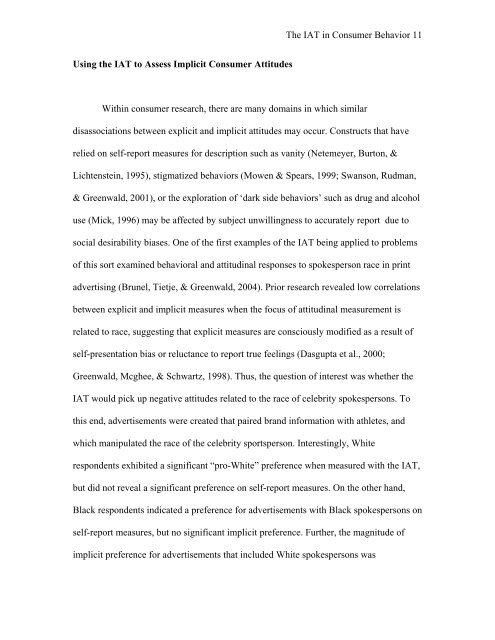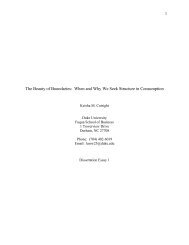RUNNING HEAD: The IAT in Consumer Behavior - Wharton Marketing
RUNNING HEAD: The IAT in Consumer Behavior - Wharton Marketing
RUNNING HEAD: The IAT in Consumer Behavior - Wharton Marketing
Create successful ePaper yourself
Turn your PDF publications into a flip-book with our unique Google optimized e-Paper software.
<strong>The</strong> <strong>IAT</strong> <strong>in</strong> <strong>Consumer</strong> <strong>Behavior</strong> 11Us<strong>in</strong>g the <strong>IAT</strong> to Assess Implicit <strong>Consumer</strong> AttitudesWith<strong>in</strong> consumer research, there are many doma<strong>in</strong>s <strong>in</strong> which similardisassociations between explicit and implicit attitudes may occur. Constructs that haverelied on self-report measures for description such as vanity (Netemeyer, Burton, &Lichtenste<strong>in</strong>, 1995), stigmatized behaviors (Mowen & Spears, 1999; Swanson, Rudman,& Greenwald, 2001), or the exploration of ‘dark side behaviors’ such as drug and alcoholuse (Mick, 1996) may be affected by subject unwill<strong>in</strong>gness to accurately report due tosocial desirability biases. One of the first examples of the <strong>IAT</strong> be<strong>in</strong>g applied to problemsof this sort exam<strong>in</strong>ed behavioral and attitud<strong>in</strong>al responses to spokesperson race <strong>in</strong> pr<strong>in</strong>tadvertis<strong>in</strong>g (Brunel, Tietje, & Greenwald, 2004). Prior research revealed low correlationsbetween explicit and implicit measures when the focus of attitud<strong>in</strong>al measurement isrelated to race, suggest<strong>in</strong>g that explicit measures are consciously modified as a result ofself-presentation bias or reluctance to report true feel<strong>in</strong>gs (Dasgupta et al., 2000;Greenwald, Mcghee, & Schwartz, 1998). Thus, the question of <strong>in</strong>terest was whether the<strong>IAT</strong> would pick up negative attitudes related to the race of celebrity spokespersons. Tothis end, advertisements were created that paired brand <strong>in</strong>formation with athletes, andwhich manipulated the race of the celebrity sportsperson. Interest<strong>in</strong>gly, Whiterespondents exhibited a significant “pro-White” preference when measured with the <strong>IAT</strong>,but did not reveal a significant preference on self-report measures. On the other hand,Black respondents <strong>in</strong>dicated a preference for advertisements with Black spokespersons onself-report measures, but no significant implicit preference. Further, the magnitude ofimplicit preference for advertisements that <strong>in</strong>cluded White spokespersons was




